NEWFOUNDLAND AND LABRADOR


ORIGIN OF PROVINCE NAME: Italian seafarer Giovanni Caboto (John Cabot) landed on the island portion of the province on 24 June 1497, on the feast of St. John the Baptist. Cabot called the newfound land "St. John's Isle" in honor of the saint, but the contraction of "a newfound land" was quickly coined and became the actual name. The name of the mainland portion is believed to come from Portuguese explorer Gaspar Corte-Real who named the area "Terra del Lavrador," or land of the farmer. Officially called "Newfoundland and Labrador," but commonly known simply as Newfoundland.
NICKNAME: The Rock.
CAPITAL: St. John's.
ENTERED CONFEDERATION: 31 March 1949.
SONG: "Ode to Newfoundland."
MOTTO: Quærite prime regnum Dei (Seek ye first the Kingdom of God).
COAT OF ARMS: In the center, the provincial shield of arms has a white cross on a red background, with two golden lions representing England and two white unicorns representing Scotland. Above the shield is an elk. Supporting the shield on either side is an Aboriginal Canadian holding a bow. Beneath the shield the provincial motto appears on a scroll, with a grassy mound.
FLAG: The flag, adopted in 1980 and based on Great Britain's Union Jack, has primary colors of red, gold, and blue set against a white background that represents snow and ice. The blue section on the left side stands for Newfoundland's Commonwealth heritage, while the red and gold section on the right side represents the hopes for the future with the arrow pointing the way.
FLORAL EMBLEM: Pitcher plant.
TARTAN: Dark green, gold, white, brown, and red on a medium green background.
PROVINCIAL BIRD: Atlantic puffin.
TREE: Black spruce.
GEMSTONE: Labradorite.
TIME: 8:30 AM NST = noon GMT; 8 AM AST = noon GMT.
1 LOCATION AND SIZE
Nestled into the northeast corner of North America, facing the North Atlantic, is Newfoundland, Canada's most easterly province. Lying between the 46th and 61st parallels, the province consists of two distinct geographical entities: Newfoundland and Labrador.
The island of Newfoundland, which forms the southern and eastern portion of the province, is a large triangular-shaped area of about 43,000 square miles (112,000 square kilometers), while the province's total area is 156,648 square miles (405,720 square kilometers). Located at the mouth of the St. Lawrence River, the island is about halfway between the center of North America and the coast of western Europe. The island of Newfoundland is separated from the Canadian mainland by the Strait of Belle Isle in the north and by the wider Cabot Strait in the south. The mainland, Labrador, is bordered by northeastern Québec. Approximately two and one-half times as large as the island, it remains a vast, unspoiled wilderness.
2 TOPOGRAPHY
The province's coastline, stretching over more than 10,500 miles (17,000 kilometers), is varied and scenic with its bold headlands, deep fjords (narrow water passages with steep shores on either side), and countless small coves and offshore islands. The interiors of both Labrador and Newfoundland have a rolling, rugged topography, deeply etched by glacial activity and broken by lakes and swift-flowing rivers. Northern Labrador is marked by the spectacular Torngat Mountains, which rise abruptly from the sea to heights of up to 5,420 feet (1,652 meters).
Newfoundland & Labrador Population Profile
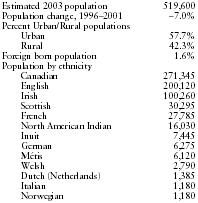
| Estimated 2003 population | 519,600 |
| Population change, 1996–2001 | –7.0% |
| Percent Urban/Rural populations | |
| Urban | 57.7% |
| Rural | 42.3% |
| Foreign born population | 1.6% |
| Population by ethnicity | |
| Canadian | 271,345 |
| English | 200,120 |
| Irish | 100,260 |
| Scottish | 30,295 |
| French | 27,785 |
| North American Indian | 16,030 |
| Inuit | 7,445 |
| German | 6,275 |
| Métis | 6,120 |
| Welsh | 2,790 |
| Dutch (Netherlands) | 1,385 |
| Italian | 1,180 |
| Norwegian | 1,180 |
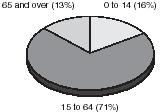

| City | Population, 2001 |
| St. John's | 122,709 |
| Corner Brook | 20,009 |
| Conception Bay South | 17,904 |
| Grand Falls-Windsor | 12,738 |
| Bay Roberts | 10,163 |
3 CLIMATE
Newfoundland's climate can best be described as moderate and maritime. The island enjoys winters that are surprisingly
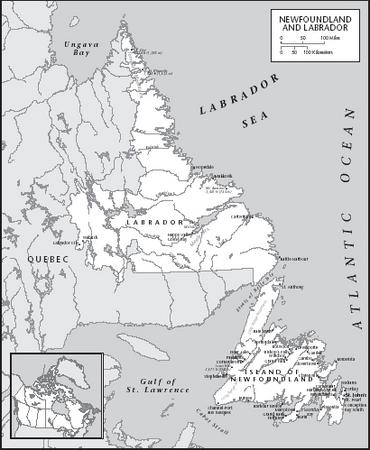
4 PLANTS AND ANIMALS
Some 22 species of whales, dolphins, and porpoises are found along the coastline—prominent species include humpback, fin, sperm, and minke whales; harbor porpoise; and saddleback dolphin. Labrador has the largest caribou herd in the world.
5 ENVIRONMENTAL PROTECTION
As in the other maritime provinces, drifting air pollution from the industrial areas of central Canada and New England are a local environmental concern. The province itself annually releases about 270,000 tons of nitrogen dioxide and carbon mon-oxide (gases that cause smog), 80,000 tons of sulfur dioxide and nitrogen oxide compounds (gases that produce acid rain), and the equivalent of 2.3 million tons of carbon dioxide. Yearly solid waste production amounted to 1,411 pounds (640 kilograms) per resident in 2002. That year, a household hazardous waste program was begun for 14 municipalities in Newfoundland and Labrador. From October 1998 to June 2001, 137,346 liters (30,216 gallons) of household hazardous waste, 1,018 propane cylinders, and 752 lead-acid batteries were safely disposed of. The province has a beverage recycling program, and a tire and oil recycling program. As of 2002, there were 240 landfills and 50 aging incinerators in use throughout the province.
6 POPULATION
The pattern of settlement in Newfoundland was mainly determined by the fishing industry, and this population distribution has persisted to today. The Avalone Peninsula and northeastern Newfoundland are the traditional bases for the fisheries and continue to be the most heavily populated areas. St. John's, the historic commercial center and capital of the island, is the province's largest city, with a population of 122,709 in 2001. Other major centers are Corner Brook (20,009), Conception Bay South (17,904), and Grand Falls–Windsor (12,738). The smaller communities—called outports—remain a major element in Newfoundland society in spite of their size. The twin towns of Labrador City and Wabush, which together form the largest urban community of Labrador, are based on the iron ore mining industries of the area.
As of 2001, the province had experienced Canada's largest decline in the population of children and young people since
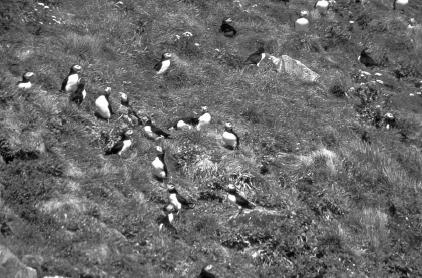
7 ETHNIC GROUPS
The province's population is largely descended from settlers from southwestern England and southern Ireland, who immigrated to Newfoundland in the late 1700s and early 1800s. In the early 1800s, disease and conflicts with settlers reduced the Beothuk Indians to extinction. There are still a relatively large number of Inuit concentrated in the coastal communities of northern Labrador. In 2001, the Aboriginal population was 16,030.
8 LANGUAGES
In 2001, 98.4 percent of all residents reported English as their native language (the highest such rate among the provinces), with 0.4 percent claiming French as their mother tongue. The Inuktitut speakers of northern Labrador accounted for about 0.1 percent.
Several distinctly local dialects of English have developed, due in part to the isolation of the province. The mixture of Irish, Dorset, and Devonshire dialects present in Newfoundland has been compared to the speech typical of early 19th century Great Britain. The local dialect of St. John's is particularly noted for its Irish tone.
9 RELIGIONS
About 60 percent of the population, or 303,195 people, are Protestant, the majority of whom are Anglicans, with members of the United Church of Canada, Pentecostals, Presbyterians, Baptists, and Lutherans also represented. The province also has about 187,400 Roman Catholics (37 percent of the population), and less than 650 people each of the following: people of Eastern Orthodox faith, Muslims, and Hindus. About 12,865 people had no religious affiliation in 2001.
10 TRANSPORTATION
A segment of the Trans-Canada Highway runs from Channel-Port aux Basques in the west to St. John's in the east, a distance of 562 miles (905 kilometers). The partially-paved Route 389 connects Labrador City and Wabash to Baie Comeau, Québec. The 327-mile (526-kilometer) Trans-Labrador Highway (Route 500) is a seasonal gravel road linking Labrador City and Happy Valley-Goose Bay. In 2003, Newfoundland had 265,457 registered motor vehicles, 1,284 registered buses, 4,303 registered motorcycles and mopeds, and 28,526 registered trailers. Urban transit consists of about 75 buses.
Newfoundland has 59 commercial ports. The port at St. John's is the busiest,
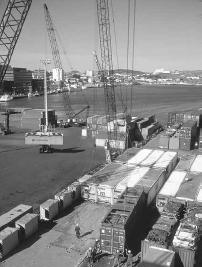
Gander International Airport is a frequent layover for long transcontinental flights. Rail service in the province was discontinued in the late 1980s.
11 HISTORY
Newfoundland is an island located off Canada's Atlantic coast. Together with the mainland area of Labrador, it forms a province of Canada. The central region of the island of Newfoundland was once the home of the now extinct Beothuk Indians. The first Europeans to visit the island were Norsemen, ancient Scandinavians who arrived there late in the 10th century. Other early visitors, such as the Basques, Portuguese, Spanish, British, and French, staged fishing expeditions there in the 16th century and probably even earlier.
European Exploration
In 1497, the Italian seafarer Giovanni Caboto (John Cabot) went to investigate the northern waters of the western Atlantic. He landed on Newfoundland on June 24 of that year, the feast day of St. John the Baptist. Cabot called the new land "St. John's Isle" in honor of the saint, and claimed it for Henry VII of England, who had financed his journey.
Conflicts between British and French colonists shaped the history of Newfoundland during the 1600s and 1700s. In 1662, France established a fort and colony at Placentia, despite protests from British merchants and fishermen. The Treaty of Utrecht, reached in 1713, ended a long period of raids and skirmishes by both nations. Great Britain was given power over the area, but France was allowed to keep its fishing rights to the island's western coastal waters.
The Island's Economy
Newfoundland's economy in the 19th century was based almost entirely on fishing. Laborers were brought in from the British Isles to work in the fisheries, thus increasing the population. Fishing rights disputes in the region continued throughout the entire century. France wanted to prohibit British colonization of Newfoundland's west coast. (The French did not want to lose their exclusive rights to fish those rich western waters.) In 1888, Newfoundland retaliated by refusing to sell bait to French fishermen. The controversy was not settled until a decade and a half later. Disputes between Québec and Newfoundland over the ownership of Labrador also erupted in 1888, but Newfoundland's control over the area was ultimately reconfirmed.
World War I (1914–1918) initially brought prosperity to Newfoundland; the demand for salt codfish was high, and prices rose considerably. However, the war effort was also costly, and the economy of the province was weakened by a lack of new industries and resources. Newfoundland's isolated location did not help matters, either. By 1918, the province was facing a debt of C $43 million; by the early 1930s, the debt had increased to C $100 million. Newfoundland's economy collapsed completely in 1932. After that, the government was reorganized, welfare and social services were established, and public health services were expanded. In addition, a guaranteed minimum price for fish was established, and the building of schooners was subsidized (aided or promoted with public money).
Following World War II (1939–1945), Newfoundland enjoyed a high level of prosperity. Its resources were in demand, it had a prosperous newsprint industry, and American army and navy air bases had been established at St. John's, Stephenville, and Argentia.
1970s–1990s
Newfoundland joined the Canadian Confederation in 1949. Joseph Smallwood became the new province's first premier and remained in power until 1979. Under his leadership a number of projects were undertaken to encourage industrial growth in Newfoundland. The development of hydroelectric power at Churchill Falls in Labrador was one of the most successful of these projects. Operations began in 1971, and by the mid-1970s, the project was issuing about 78% of the hydroelectricity produced in the province.
The 1979 discovery of oil at Hibernia marked the first major oil find in Newfoundland. During the early 1980s, though, Newfoundland clashed with the federal government over the development of this vast offshore oil and natural gas field.
For the average worker in Newfoundland in the 1970s and 1980s, times were still tough. Many Newfoundlanders left the province seeking better opportunities in other parts of Canada. Economic prospects for Newfoundland brightened in 1994 with the discovery of nickel, copper, and cobalt at Voisey's Bay.
In March of 1995, the waters off the coast of Newfoundland became the scene of a tense confrontation when Canadian ships pursued and seized the Spanish fishing trawler Estai in international waters. A month later, the European Union and Canada agreed to settle their differences by temporarily establishing a higher catch quota for European fishing vessels. The Canadian government also agreed to repeal (cancel or abolish) the legislation that allowed it to seize vessels in international waters.
Facing the Future
The year 1997 was an exciting one for Newfoundland. Production began at Hibernia oilfield, and the province celebrated the 500th anniversary of its "discovery" with the Cabot 500, a year-long festival in honor of the man who brought Newfoundland to the attention of the world. In December 2001, the province was renamed Newfoundland and Labrador by the Canadian government. Roger Grimes became Premier of Newfoundland and Labrador in February 2001. His government opposed secession, or separation, from the rest of Canada, but some critics still question whether the province has benefited from membership in the Canadian Confederation. In the early 2000s, a Royal Commission consulted with citizens to determine Newfoundland and Labrador's place in the federation and how best to achieve prosperity in the province.
In 2004, Newfoundland and Labrador had a budget deficit of C $827.5 million. Schools, hospitals, and roads were receiving inadequate funds. Premier Danny Williams called for hard work and sacrifice from citizens. He pledged to tackle the budget deficit, but also to grow the economy, create jobs, and expand the province's revenue base.
12 PROVINCIAL GOVERNMENT
The structure of the provincial government reflects that of the federal government. For example, the provincial premier, as the majority party leader of the legislature, functions much like the Canadian prime minister. Provincial legislators, like their federal counterparts in Parliament, are elected to represent a constitutional jurisdiction and pass legislation. They do so as members of the 48-seat House of Assembly. A provincial lieutenant-governor approves laws passed by the legislature, much like the Governor General at the federal level. There is no provincial equivalent, however, to the federal Senate.
13 POLITICAL PARTIES
Local politics in Newfoundland from 1824 to the early 1900s was largely oriented around religious factions. From 1908 to 1932, the Newfoundland Fishermen's Protective Union (NFPU) was a dominant force in local politics. The Confederation Association, which played an instrumental role in Newfoundland's entry into the confederation in 1949, became the province's Liberal Party, while many who had opposed confederation allied themselves with the Progressive Conservative Party. The Liberal Party controlled provincial politics from the late 1940s to the late 1960s.
The most recent general election was held on 21 October 2003. Legislative seats in 2003 (after the election) were held by 12 Liberals, 34 Progressive Conservatives, and 2 New Democrats.

| Term | Premier | Party |
| 1949–72 | Joseph Roberts Smallwood | Liberal |
| 1972–79 | Frank Duff Moores | Conservative |
| 1979–89 | Alfred Brian Peckford | Conservative |
| 1989 | Thomas Gerard Rideout | Conservative |
| 1989–1996 | Clyde Kirby Wells | Liberal |
| 1996–00 | Brian Tobin | Liberal |
| 2000–01 | Beaton Tulk | Liberal |
| 2001–03 | Roger Grimes | Liberal |
| 2003– | Danny Williams | Conservative |
14 LOCAL GOVERNMENT
The Department of Municipal and Provincial Affairs Act grants the provincial government political power over the actions of the municipalities, except for the cities of St. John's, Corner Brook, and Mount Pearl. Although towns and communities have a large degree of freedom in financial affairs, the provincial government routinely inspects municipal finances. The incorporated cities, towns, and municipalities have the power to collect taxes; provide basic public services, fire protection, and recreational services; and make bylaws. Elections for city and town councils occur every four years, while community councils are elected every other year.
15 JUDICIAL SYSTEM
North America's first court of justice was established in Trinity in 1615. The Canadian Constitution grants provincial jurisdiction over the administration of justice, and allows each province to organize its own court system and police forces. The federal government has exclusive domain over cases involving trade and commerce, banking, bankruptcy, and criminal law. The Federal Court of Canada has both trial and appellate divisions for federal cases. The nine-judge Supreme Court of Canada is an appellate court that determines the constitutionality of both federal and provincial statutes. The Tax Court of Canada hears appeals of taxpayers against assessments by Revenue Canada.
The provincial court system consists of the Provincial Court of Newfoundland, which hears most criminal cases, as well as some family law matters, youth proceedings, and small claims; the Supreme Court of Newfoundland (Unified Family Court), which hears most family law matters, including divorce; the Supreme Court of Newfoundland (Trial Division), which is the trial court hearing serious civil and criminal cases; and the Supreme Court of Newfoundland (Court of Appeal), which is the highest court in the province, hearing appeals from the Provincial Court, Unified Family Court, and Trial Division of the Supreme Court of Newfoundland.
In 2002, there were 2 homicides in Newfoundland. That year, there were 894 violent crimes per 100,000 persons, and 2,422 property crimes per 100,000 persons.
16 MIGRATION
In 2001, 32.3 percent of the 8,030 immigrants living in Newfoundland had come from the United Kingdom, 19.9 percent from the United States, 11.3 percent from Northern and Western European countries other than the United Kingdom, and 7.5 percent from Southern Asia (mostly from India).
In 2001, 0.5 percent of Newfoundland's residents age 5 and older were living abroad. Some 8.5 percent were living elsewhere in Newfoundland, while 3.3 percent were living in another province. Ontario is the leading province of destination for residents leaving Newfoundland to live in some other province, as well as the province of origin for most incoming internal migration into Newfoundland.
17 ECONOMY
Since its first settlement, Newfoundland and Labrador has been highly dependent on its resource sector, especially fisheries. Coastal towns provided support for the vessels fishing the Grand Banks. The main industries today are mining, manufacturing, fishing, pulp and paper, and hydro-electricity. Other natural resources important to the local economy include iron ore from Labrador and the development of substantial offshore oil and natural gas reserves. In 2002, Newfoundland's gross domestic product (GDP) totaled C $16.6 billion, or about 1.4 percent of the national total.
18 INCOME
As of 2000, average weekly earnings in the province amounted to C $556.75. The same year, the average family income was C $51,424 for a family of five.
19 INDUSTRY
In addition to fish products, newsprint, and refined petroleum, companies in the province also manufacture such items as boats, lumber, chemical and oil-based products, food and beverages, clothing, and footwear. Fish products, newsprint, and refined petroleum products accounted for about 60 percent of all manufacturing output and 65 percent of employment in industry in 2002. In total, the province shipped over C $2.23 billion in manufactured products in 2002.
Manufacturing investment was expected to reach C $135 million in 2003. Employment in industry was 15,800 persons per month in the first ten months of 2003.
20 LABOR
In 2003, the total labor force was 254,000. Total provincial employment was around 211,900, and there were 42,200 persons unemployed. The average annual unemployment rate was 16.6 percent in 2003, the highest rate among the provinces. The hourly minimum wage as of January 2004 was C $6.00, the second-lowest rate among the provinces. Only Alberta had a lower hourly minimum wage, at C $5.90.
In 2003, the sectors with the largest numbers of employed persons were: trade, 33,500; health care and social services, 32,300; forestry, fishing, mining, and oil and gas, 17,300; educational services, 16,300; public administration, 16,200; manufacturing, 15,600; accommodation and food services, 13,300; other services, 13,100; transportation and warehousing, 12,600; construction, 9,500; finance, insurance, real estate and leasing, 8,500; management, administrative, and other support, 7,800; information, culture, and recreation, 7,000; professional, scientific, and technical services, 6,900; utilities, 3,000; and agriculture, 800.
Of the four maritime provinces, Newfoundland is often the hardest hit by economic recessions and declines in the resource sectors.
21 AGRICULTURE
Newfoundland's agriculture industry is small compared with other Canadian provinces. The output of the agriculture industry is mainly for local consumption, although some agricultural products such as blueberries are sold to markets outside the province. In 2001, Newfoundland had 643 farms, with an average size of 156 acres (63 hectares). The main crops are hay, potatoes, alfalfa, blueberries, rutabagas, and cabbage.
In 2000, farm receipts in the province (excluding forest products sold) totaled C $90.4 million. Farmers' operating expenses equaled C $78.8 million. The average farmer was left with C $18,006 before interest payments and taxes.
22 DOMESTICATED ANIMALS
One of the earlier attempts at animal breeding in the province is the famous web-footed Newfoundland dog, which is descended from the crossing of the American black wolf (tamed by the Native people) with the great bear dogs brought over by the Vikings. Another dog breed, the Labrador Retriever, was originally bred in Labrador to retrieve waterfowl for hunters and fish for anglers.
Meat and dairy production is for local consumption. In 2001, Newfoundland had 9,483 head of cattle, 4,708 dairy cows, 2,689 pigs, and 7,888 sheep. In 2003, the poultry population was 541,559, and there were 20 chicken producers.
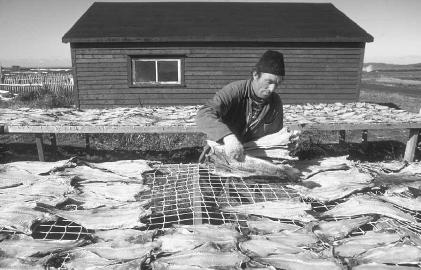
23 FISHING
The province was initially settled because of its rich fishing grounds on the "nose" and "tail" of the Grand Banks. The mainstay of the province's fishing industry historically has been groundfish (primarily cod). However, shrimp, crab, lobster, Greenland turbot, clam, and scallop are presently the most valuable species. Other important catches are flounder, redfish, and capelin. Shellfish account for roughly 80 percent of the total value of commercial landings. In 2003, the Newfoundland and Labrador exported 155.5 million tons of fish and shellfish. The total value of fish exports that year was over C $1 billion, second only to Nova Scotia.
Protection of the rich fishery resources off the coast of Newfoundland has been an ongoing concern and one that has become more serious in recent years. In 1977, the Canadian government extended its fishery jurisdiction to 200 miles (125 kilometers) around the coast of the province in an attempt to gain better control of fishing activity. This move produced positive results in the 1980s, but in 1989 scientific studies revealed that some of the Atlantic's key groundfish stocks were in severe decline. Since that period, there have been several reductions in fishing quotas.
In 2000, Newfoundland and Labrador had 101,945 residents actively engaged in sport fishing within the province.
24 FORESTRY
About 60 percent of the province's land area is covered by forests. Much of the island and southern and central Labrador is covered by a thick boreal forest of black spruce and balsam fir mixed with birch, tamarack, and balsam poplar. Northern Labrador is largely devoid of forest. In 2000, the total timber harvest was 57,369 acres (23,216 hectares).
The third-largest traditional goods-producing industry is the newsprint industry. This industry consists primarily of three pulp and paper mills, located in Corner Brook, Grand Falls, and Stephenville. In 2002, exports of forestry products had a value of C $782 million, with newsprint accounting for 96 percent. In 2002, the forest industry directly employed 3,500 persons.
25 MINING
Iron ore from Labrador is the principal mineral produced in the province. Other minerals are gold, asbestos, limestone, and gypsum. In 2003, Newfoundland and Labrador produced 1,083 kilograms of gold. In the mid-1990s, prospectors discovered rich deposits of nickel, cobalt, and copper in the Voisey Bay region of Labrador. Excavation was delayed because of Innu and Inuit land claims.
In 2003, the total value of mineral production was about C $936.6 million, of which metals accounted for 95 percent, and industrial minerals, 4.7 percent. Mineral fuels production was negligible.
26 ENERGY AND POWER
The discovery of offshore oil and gas reserves added a new dimension to the marine resources of the province. The Hibernia discovery in 1979 was Newfoundland's first significant oil find; reserves are estimated at 750 million barrels. Currently under way, Hibernia is the largest construction project in North America. Cumulative production from November 1997 (when oil production first began) until January 2004 was 308.5 million barrels. Terra Nova started production in January 2002, and was expected to produce 36 million barrels of oil.
The province's largest utility industry is electric power. The largest hydroelectric facility is located in Churchill Falls, Labrador, with a total installed capacity of over 5,000 megawatts. Newfoundland Power and Newfoundland and Labrador Hydro are the two utilities responsible for generating and distributing electricity.
27 COMMERCE
In 2002, total merchandise exports amounted to C $5.6 billion and imports totaled C $1.8 billion. The United States was the largest export market ( C $4.2 billion), followed by Germany, China, the United Kingdom, and Italy. The major
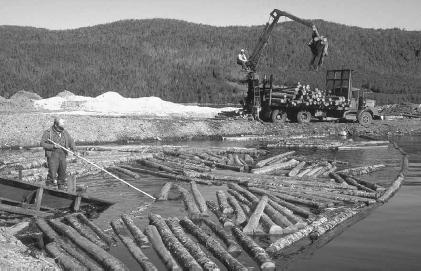
28 PUBLIC FINANCE
The fiscal year runs from 1 April to 31 March. For fiscal year 2002/03, total revenues were C $3.98 billion; expenditures totaled C $4.04 billion. The largest expenditure areas were health, education, debt charges and other financial expenses, social welfare, general government, and transportation and communication. In the 2002/03 fiscal year, provincial debt amounted to 47 percent of the gross domestic product.
29 TAXATION
The basic personal income tax rate in 2003 was 42.7 percent. The retail sales tax was 8 percent. Major consumption taxes are levied on gasoline ( C $0.165 per liter) and tobacco ( C $27 per carton).
The average family of four (two parents and two children) in 2003 earned C $64,555. Such a family paid C $29,314 in taxes.
Corporate income tax rates in 2003 were as follows: small business rate, 5 percent; general business rate, 14 percent; and capital tax rate for financial institutions, 4 percent.
30 HEALTH
In 2001, there were 4,716 live births in Newfoundland, a decrease of 3.1 percent from 2000. There were 4,151 deaths that year, a decrease of 4.3 percent from 2000. Life expectancy for men in 2001 was 75.8 years, and 80.9 years for women. Reported cases of selected diseases in 2002 included chicken pox, 369; campylobacteriosis, 45; salmonellosis, 50; and giardiasis, 35. Between November 1985 and June 2003, 210 residents had become infected with HIV, the virus that causes AIDS.
31 HOUSING
Newfoundland had 189,040 households in 2001, with an average size of 2.7 persons. There were 142,330 households living in single-detached houses, 945 households living in apartments in buildings with five or more stories, 1,350 households living in mobile homes, and 44,415 households living in other dwellings, including row houses and apartments in buildings with fewer than five stories. In 2002, the value of investment in residential construction was C $701.5 million.
32 EDUCATION
The population of Newfoundland and Labrador declined during the late 1990s. Enrollment in elementary and secondary schools in the province declined by 14 percent from 1995 to 2000. The number of teachers declined by 13 percent during the same period. There were 95,000 students enrolled in elementary and secondary schools, including about 5,000 in Labrador.
The Memorial University of Newfoundland at St. John's, founded in 1925, is the province's only university, with over 16,000 full-time students enrolled in 2003–04. Full-time enrollment in career programs in postsecondary community colleges is about 6,000.
33 ARTS
Newfoundland's performing arts companies give over 250 performances before a total attendance of over 50,000 each year. Some of the companies are the Kittiwake Dance Theater and the Shakespeare by the Sea Festival in St. John's, the Rising Tide Theater Company, which performs in several cities, and the Woody Point Heritage Theater in Woody Point, where traditional Newfoundland music and dance productions are performed. Several craft studios such as the Central Newfoundland Visual Arts Society in Grand Falls–Windsor exhibit local art work, which includes pottery, quilting, weaving, paintings, and photography.
34 LIBRARIES AND MUSEUMS
Public library services are provided through the Provincial Information and Library Resources Board, which oversees approximately 100 community public library systems. Museums in St. John's include the Newfoundland Museum, the Newfoundland and Labrador Museum of Transportation, the Royal Newfoundland Constabulary Museum, and the Art Gallery of Newfoundland and Labrador at the Memorial University of Newfoundland. The Newfoundland Museum has regional branches in Grand Bank (Southern Newfoundland Seamen's Museum) and Grand Falls–Windsor (Mary March Regional Museum).
35 COMMUNICATIONS
As of 2001, Newfoundland had 19 AM and 7 FM radio stations, and 18 television stations.
36 PRESS
Newfoundland has two daily newspapers: the Evening Telegram (St. John's) and The Western Star (Corner Brook).
37 TOURISM, TRAVEL, AND RECREATION
Newfoundland strives to develop a solid tourism industry. The province's rich cultural and historical heritage and unique character are considered to be major selling features to other Canadians and travelers from around the world. In 2001, about 427,700 non-residents visited the province. Tourism revenues that year were C $291 million.
The Trinity summer festivals, presented by Rising Tide Theater, drew 25,000 visitors in 2002. The plays interpret the area's history through theater. The Johnson Geo Center in St. John's, a world-class geological museum, is located underground. It opened in June 2002. The Red Bay National Historic Site is the site of a 16th century Basque whaling station. The Bonne Bay Marine Station and Ocean Observatory is another attraction. The Signal Hill Tatoo is a 19th century reinactment that takes place every summer.
38 SPORTS
Regattas are commonly held throughout the province, including the Royal St. John's Regatta, North America's oldest continuously held sporting event. The World Women's Fast Pitch Softball Tournament was held in St. John's in 1994.
39 FAMOUS NEWFOUNDLANDERS
Noted poet Edwin J. Pratt (1883–1964) was a native of Western Bay. Other important writers from the province include Cassie Brown (1919–86), born in Rose Blanche; Percy Janes (1922–99), from St. John's; and Kevin Major (b.1949), born in Stephenville. Actress Shannon Tweed (b.1957) is also a native Newfoundlander.
Born in Bishop's Falls, Alex Faulkner (b.1935) was the first Newfoundlander to play in the National Hockey League (NHL).
40 BIBLIOGRAPHY
Jackson, Lawrence. Newfoundland and Labrador . Minneapolis: Lerner Publications, 1995.
Johnston, Wayne. Baltimore's Mansion: A Memoir. New York: Doubleday, 2000.
LeVert, Suzanne. Newfoundland . Philadelphia: Chelsea House, 2001.
White, Marian Frances. Discover Canada: Newfoundland and Labrador . Toronto: Grolier, 1994.
Web sites
Canada Tourism. http://www.canadatourism.com/ctx/app (accessed on March 19, 2004).
Government of Newfoundland and Labrador. http://www.gov.nf.ca/ (accessed on March 19, 2004).
Statistics Canada. http://www.statcan.ca/english (accessed on March 19, 2004).
PeAcE
I am doing a project at school, i didn't find a lot useful info, that is because i need the info around 1860's.
Anyways, the info is great, keep up the good work, may be some info about Newfoundland in 1860s!:)
(I learn a few things aswell :))
this helped me soo much i love this site why do i love this site so much? i don't know but this is awsome
5 stars ;)
:D
geez this is hella great info